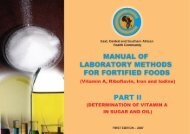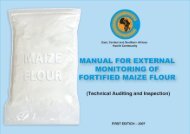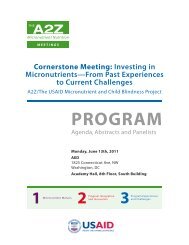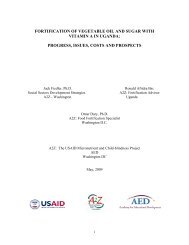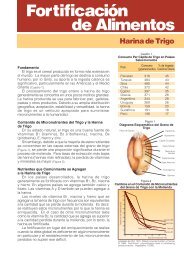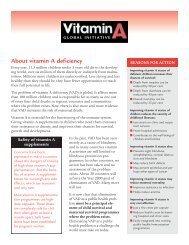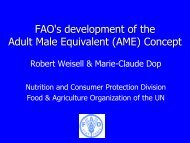manual of methods for determining micronutrients in fortified foods
manual of methods for determining micronutrients in fortified foods
manual of methods for determining micronutrients in fortified foods
Create successful ePaper yourself
Turn your PDF publications into a flip-book with our unique Google optimized e-Paper software.
C. Determ<strong>in</strong>ation <strong>of</strong> niac<strong>in</strong> <strong>in</strong> flours by high per<strong>for</strong>mance liquid<br />
chromatography<br />
I. Reference<br />
Tyler TA and Genzale JA. 1990.Liquid Chromatographic Determ<strong>in</strong>ation <strong>of</strong> Total Niac<strong>in</strong> <strong>in</strong> Beef,<br />
Semol<strong>in</strong>a, and Cottage Cheese. J Assoc Off Anal Chem 73 (3):467-469.<br />
II. Pr<strong>in</strong>ciple<br />
Niac<strong>in</strong> is extracted with an alkal<strong>in</strong>e digestion with calcium hydroxide. Excess calcium is precipitated<br />
and pH is adjusted prior to solid-phase cleanup. Sample extract is cleaned up us<strong>in</strong>g a C18 cartridge.<br />
Niac<strong>in</strong> is collected after impurities have been separated. The pH <strong>in</strong> the sample extract is acidified and<br />
the extract is <strong>in</strong>jected <strong>in</strong> a C18 column us<strong>in</strong>g sodium dodecyl sulfate and acetonitrile <strong>in</strong> the mobile phase.<br />
III. Critical po<strong>in</strong>ts<br />
Adjust<strong>in</strong>g pH is critical <strong>in</strong> the different steps. First, calcium hydroxide is elim<strong>in</strong>ated by precipitation<br />
with oxalic acid, decreas<strong>in</strong>g pH to 6.5-7.0. Then, pH must be neutral s<strong>in</strong>ce niac<strong>in</strong> is not reta<strong>in</strong>ed on the<br />
C18 column at this pH, whereas a large number <strong>of</strong> colored compounds are reta<strong>in</strong>ed, obta<strong>in</strong><strong>in</strong>g a cleaned<br />
extract. F<strong>in</strong>ally, the pH is acidified to reach the same pH as the mobile phase.<br />
The filtration process is slow and time consum<strong>in</strong>g. It is recommended to centrifuge the extracts prior to<br />
filtration to accelerate the process.<br />
A good separation is obta<strong>in</strong>ed <strong>in</strong> the chromatogram when us<strong>in</strong>g the comb<strong>in</strong>ation <strong>of</strong> SDS and acetonitrile<br />
<strong>in</strong> the mobile phase, but both reagents must be very pure to obta<strong>in</strong> a stable basel<strong>in</strong>e.<br />
IV. Materials and equipment<br />
• Autoclave 121-123°C<br />
• Agitator Vortex type<br />
• Analytical balance (± 0.0001 g)<br />
• HPLC system<br />
− Pump operat<strong>in</strong>g cont<strong>in</strong>uously at 1.0-2.0 mL/m<strong>in</strong> with a flow precision <strong>of</strong> ± 1% or better<br />
− Injector. A <strong>manual</strong> <strong>in</strong>jector or auto sampl<strong>in</strong>g <strong>in</strong>jector with a 100 μL fixed loop hav<strong>in</strong>g a typical<br />
sampl<strong>in</strong>g precision <strong>of</strong> ±0.25% or better<br />
− Reverse-phase C18 column, 5 µm (4.1x250 mm)<br />
− UV detector<br />
• C 18<br />
cartridges (Sep-pak). Waters.Sep-pak Cartridges C 18<br />
Vac 3cc (500 mg).<br />
• Erlenmeyer flasks (250, 500 mL)<br />
• Volumetric flasks (25, 100 and 1000 mL)<br />
• Beakers (25, 100 and 1000 mL)<br />
• Glass funnels<br />
• Volumetric pipettes<br />
• Graduated cyl<strong>in</strong>ders<br />
• Glass rods<br />
• Filter paper Whatman No. 42 and 2.<br />
- 47 -






